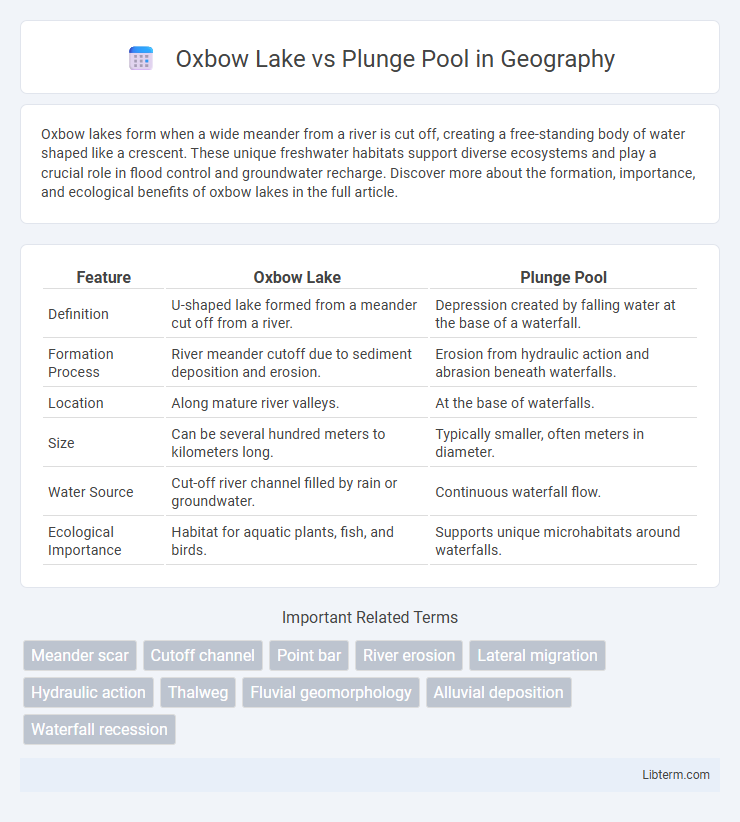Oxbow lakes form when a wide meander from a river is cut off, creating a free-standing body of water shaped like a crescent. These unique freshwater habitats support diverse ecosystems and play a crucial role in flood control and groundwater recharge. Discover more about the formation, importance, and ecological benefits of oxbow lakes in the full article.
Table of Comparison
| Feature | Oxbow Lake | Plunge Pool |
|---|---|---|
| Definition | U-shaped lake formed from a meander cut off from a river. | Depression created by falling water at the base of a waterfall. |
| Formation Process | River meander cutoff due to sediment deposition and erosion. | Erosion from hydraulic action and abrasion beneath waterfalls. |
| Location | Along mature river valleys. | At the base of waterfalls. |
| Size | Can be several hundred meters to kilometers long. | Typically smaller, often meters in diameter. |
| Water Source | Cut-off river channel filled by rain or groundwater. | Continuous waterfall flow. |
| Ecological Importance | Habitat for aquatic plants, fish, and birds. | Supports unique microhabitats around waterfalls. |
Introduction to Oxbow Lakes and Plunge Pools
Oxbow lakes form when a river meander is cut off from the main channel, creating a crescent-shaped, isolated water body rich in sediment and biodiversity. Plunge pools develop at the base of waterfalls due to the erosive force of falling water, resulting in deep, circular basins carved into bedrock. Both features represent distinct fluvial processes shaping landscapes through erosion and deposition.
Formation Processes: Oxbow Lakes vs Plunge Pools
Oxbow lakes form through the meandering process of rivers, where erosion and deposition isolate a river bend, creating a crescent-shaped water body. Plunge pools develop at the base of waterfalls, resulting from the erosive force of falling water scouring and deepening the riverbed. Both features illustrate distinct geomorphological processes: fluvial meandering versus vertical hydraulic erosion.
Geographical Locations and Occurrence
Oxbow lakes commonly form in the floodplains of meandering rivers such as the Mississippi River in the United States and the Ganges in India, representing abandoned river bends. Plunge pools are typically found at the base of waterfalls in mountainous or hilly regions, like the plunge pools beneath Niagara Falls in North America and Victoria Falls in Africa. Both features arise from distinct geomorphological processes but differ in their typical geographical settings, with oxbow lakes associated with low-gradient river plains and plunge pools linked to vertical water erosion in steep terrains.
Physical Characteristics and Features
Oxbow lakes are crescent-shaped water bodies formed from cut-off meanders, characterized by shallow depths and calm waters with sediment accumulation. Plunge pools are deep, bowl-shaped depressions at the base of waterfalls, created by erosive forces of falling water and turbulent swirls. The physical distinction lies in oxbow lakes' flat, sediment-filled basin versus plunge pools' steep-sided, rock-carved, and highly erosive environment.
Hydrological Significance
Oxbow lakes form through river meandering and cutoff, creating isolated water bodies crucial for groundwater recharge and habitat diversity. Plunge pools, occurring at the base of waterfalls due to erosive water force, play key roles in sediment transport and energy dissipation within river systems. Both features influence hydrological processes but differ in formation and impact on aquatic ecosystems.
Differences in Ecological Impact
Oxbow lakes and plunge pools differ significantly in their ecological impacts due to their formation and hydrological characteristics. Oxbow lakes, formed from former river meanders, often serve as nutrient-rich habitats supporting diverse aquatic plants, fish, amphibians, and bird species, contributing to high biodiversity and ecological productivity. Plunge pools, created by the erosive action beneath waterfalls, typically have lower nutrient loads and support specialized aquatic communities adapted to fast-flowing, oxygen-rich environments, resulting in distinct but less diverse ecological niches compared to oxbow lakes.
Role in River Morphology and Dynamics
Oxbow lakes form from river meanders cut off due to sediment deposition, playing a crucial role in floodplain development and channel migration by creating distinct aquatic habitats that influence river biodiversity and sediment distribution. Plunge pools develop at the base of waterfalls or rapids through erosive hydraulic action, impacting riverbed morphology by deepening scour holes that alter flow velocity and sediment transport downstream. Both features contribute significantly to river morphology and dynamics by modifying flow patterns, sediment deposition, and habitat diversity within fluvial systems.
Notable Examples Around the World
Oxbow lakes such as Lake Chicot in Arkansas, USA, and the Killer Lakes in New Zealand exemplify the distinct crescent-shaped water bodies formed by river meander cut-offs, preserving rich ecosystems and sedimentary histories. Plunge pools, found beneath famous waterfalls like Niagara Falls in North America and Gullfoss in Iceland, showcase powerful erosive action with deep, circular basins carved by swift, cascading water. Both landforms are vital for understanding fluvial processes and the dynamic interactions between water flow and geological substrates worldwide.
Human Interaction and Uses
Oxbow lakes provide fertile soil for agriculture and often become valuable habitats for wildlife, attracting fishing and recreational activities near rural communities. Plunge pools, commonly found at the base of waterfalls, offer unique environments for swimming and scientific study of erosion processes, often integrated into ecotourism sites. Human interaction with oxbow lakes tends to emphasize resource use and habitat conservation, while plunge pools primarily serve educational and recreational purposes.
Summary: Key Distinctions and Importance
Oxbow lakes form from river meanders cut off by sediment deposition, creating crescent-shaped bodies of water essential for wetland ecosystems and biodiversity. Plunge pools develop at the base of waterfalls due to the erosive action of falling water, serving as key geological indicators of water flow and erosion. Understanding these distinct formations highlights their roles in shaping landscapes and supporting diverse habitats in fluvial environments.
Oxbow Lake Infographic

 libterm.com
libterm.com